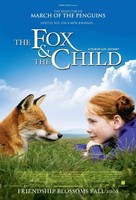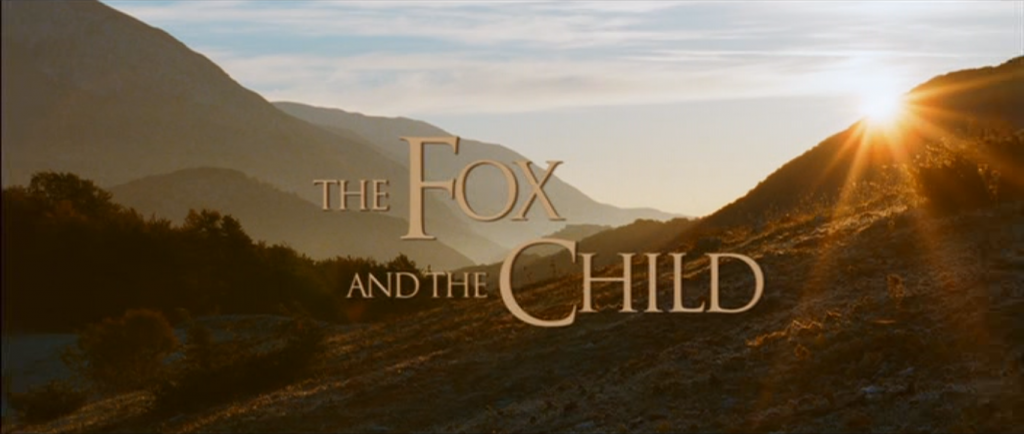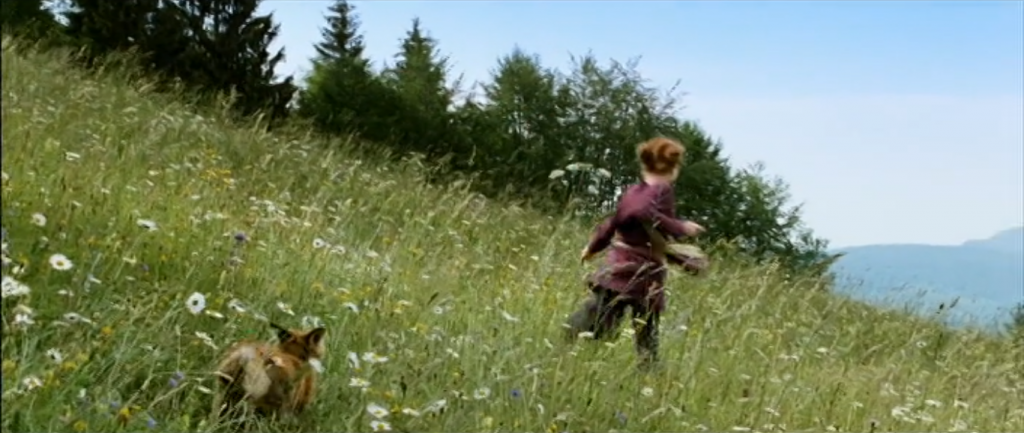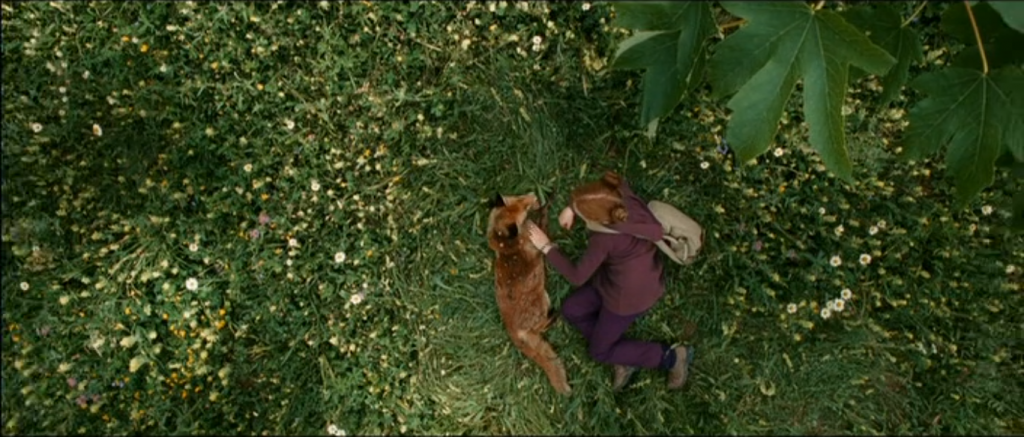
When asked in an interview how he approached making The Fox and the Child (2007) following the popularity of The March of the Penguins (2005), French director Luc Jacquet replied:
I went into my childhood; into a memory I have of having looked into the eyes of a wild fox when I was a kid. I also noticed that of all the encounters in the world I have had with animals, that when you lock eyes with an animal, something happens that’s very difficult to describe but that is very powerful. [1]
The Fox and the Child, as the title suggests, centres on a friendship forged between a young, unnamed girl (Bertille Noël-Bruneau) and a fox. After their first encounter, which mirrors Jacquet’s recollection, the Girl quickly establishes a psychological ownership over the animal, describing it as ‘my fox’. Due to an injury from playing in the forest, the Girl is forced to spend the winter confined to her bedroom. The arrival of spring heralds recovery, and the united pair spend the bulk of the film exploring the forest together, going on adventures, meeting (and evading) the forest’s other inhabitants, and developing a close bond. However, the Girl desires a closer friendship, bringing the animal into her home in the climax of the film. This is a step too far: the fox panics, jumping out of a window and falling unconscious. Although the fox survives, the two never truly resolve their friendship. In addition to action and dialogue driving the plot, the film also includes a voiceover of the Girl (now an adult) remembering the experience. She narrates the story, adding philosophical platitudes and musings on love, and animals, concluding the film by accepting that the almost disastrous ending to her friendship with the fox was inevitable: ‘we could never truly be friends’.

The Fox and the Child is a family drama, taking place from the perspective of a child, an intimate position which allows Jacquet to stretch or exaggerate the truth to suit the vivid imagination of the child. This is not a fantasy film – everything which happens on the screen is feasible – but through the eyes of an inquisitive child magic and wonder hides beneath every rock and behind every tree. The scenes shared by the fox and the child are breath-taking, both for their beauty (the film is highly stylised) and because the animal’s tameness is almost unbelievable.
The film borrows heavily from so-called ‘blue chip’ nature documentaries; the scenes of the fox and the child are interspersed with shots of forest creatures in their natural habitats, and visually stimulating panoramas of French and Italian scenery. Like modern wildlife documentaries, the imagery and behaviour of animals is assisted by the soundtrack for dramatic effect.

The climactic disaster – where the Girl takes the fox into her bedroom, resulting in the animal almost dying – is gravely foreshadowed. This prophetic scene begins with the Girl leading the fox through the forest (‘Come on, let’s have a race!’), which is a warning in itself; thus far the fox has been portrayed as the one in command, with an unrivalled knowledge of the forest’s mysteries, while the Girl has followed inquisitively. They stumble upon a fire: the film is distinctly absent of many human presences, especially in the forest, where the Girl is the sole person, so this is another warning, signifying humanness. The Girl is inspired by the fire: ‘Let’s play something. Let’s say it’s winter and there’s snow and you’ve come to my house to get warm.’ She begins constructing a simple plan of a house using logs to represent the walls and leaves a gap for the door. ‘Are you coming in?’ she asks, and Jacquet cuts to the fox’s indifferent reaction, sniffing suspiciously. The Girl is committed and ties a piece of material around the fox’s neck, saying ‘let’s pretend this is your collar’. She acts as though this is a game, but it is not ‘pretend’, the collar is real, and her desire to make the animal her pet is real too. A boundary is crossed, quite literally, when the fox enters the makeshift house. The log walls literalise the border between being a wild animal and a domesticated pet; as the fox steps over the threshold, its relationship with the Girl changes. However, the Girl’s plan is not as successful as she hoped. The fox does not use the door, instead the animal hops over a log, to the Girl’s frustration: ‘Uh’, she cries, ‘you just hit your head against the wall.’ While the Girl was able to join with the fox’s games, such as chasing frogs, the fox does not comprehend the Girl’s.

The fox’s failure to follow the game’s established rules and recognise the boundary of the symbolic house signifies the impossibility of taming or controlling such a wild animal. The Girl ties string to the pretend collar, making a lead, surprising the fox who turns vicious and bites the string, fleeing. The scene is a step forward (and two steps back) in their friendship, with the Girl attempting (and failing dramatically) to bring the fox out of the wild and into the domestic. This attempt is literal, with an actual physical capture, and metaphorical, with the incident taking place in the pseudo-domestic setting of the fake house. The Girl’s imagination can accommodate the natural play of a fox (stealing food, running through forest) as a game which she is able to share in, but the fox’s reaction to her game is too frustrating, and does not follow her schema. While much of the film presents the pair as harmonious, the Girl upsets this balance with her attempt to force the fox to cross the division between wild and captive. Jacquet suggests that this barrier cannot be broken.

Over the winter period, the injured Girl has only a non-fiction book ‘on the life of foxes’ and her imagination to substitute the creature itself. In a voiceover she explains: ‘I knew [the book] almost by heart. I tried to imagine him.’ With those words, the scene cuts to the fox alone in the snowy habitat, as we shift into the confusing territory of the child’s imagination. Jacquet regularly reminds us that what the audience is seeing here is not the true winter activity of the individual fox, but a formation of the Girl’s mind, by regularly returning to quick shots of her immersed in her book, and with the use of voiceover. The Girl says that ‘[she] was becoming, little by little, like a fox in the middle of winter’, and thus we enter the perspective of her imagined fox, hunting for voles in the snow. While the visual perspective remains in the third person, with the fox in frame, the sound of the scene is heightened, as though the camera microphone now has the vulpine ears. The camera passes under the snow, showing the squeaking voles below, and then returns above, showing the fox rooting around. When it returns, the camera is close up on the fox, and we hear what the animal hears, with the squeaks of the voles amplified and multiplied beyond the capacity of human ears. Jacquet’s claims that the film is ‘trying to get as close as possible to reality’, [2] therefore this is his impression of the fox’s reality. He suggests that the mind of a child, blending factual content found in books with imagination, can offer an accurate understanding of a fox’s reality.
In one imagined scene, a lynx chases the fox, which heavily resembling nature documentaries, barring omission of a narrator. As Catherine Wheatley describes in Sight and Sound:
Without an omniscient Attenborough-style expert to explain the behaviour of the animals that inhabit this landscape, there’s a similarly childlike tendency to understand them in terms of human emotions, an inclination encouraged here by the film’s symphonic scoring. [3]
Through the imagination of the child, the fox and the lynx are not understood in factual documentary terms as hunted and hunter but characterised in child-like cinematic fashion as good and evil. The lynx enters the frame, its stalking footsteps in the snow triggering a deep, typically villainous instrumental soundtrack, as Wheatley alluded. The lynx begins its chase, running through the deep snow, while the dramatic score plays. Jacquet adds to the diegetic sound with recordings of lynx roars and fox screams. These sounds heighten the imagery on screen in an attempt to achieve the reality desired by the director; without sound, the audience would be aware of the artifice of the scene, but instead all the viewer’s senses are distracted, immersed in the spectacle. Then there is a suspenseful interlude, where it seems the fox has escaped, before the lynx picks up the chase again. The tension is built with the score, and the intimacy of the fox in the frame evokes sympathy with an apparently frightened animal. Jacquet even shows the fox’s beating russet chest, a technique to demonstrate its fear.
Derek Bousé argues that these intimate techniques used in nature documentaries affect audiences’ understandings of scientific truth:
Given that animals are subtly humanized by the very forms of wildlife films, it should not be surprising that we can empathize and identify with them as we do with people. […] Are we aware of how this might be altering our perceptions of wild animals, our understanding them, and our relationship to them? [4]
Bousé references the use of close-ups and point-of-view shots of prey animals looking into camera and then cutting to the hunting animal, an editing device which implies emotion. Jacquet uses such shots in order to paint the fox as a protagonist and the lynx as antagonist, which Bousé would criticise because it disconnects the animals’ apparent emotion within the film from their real behaviour during filming:
a shot depicting an animal who is carefully watching a cameraman it may perceive as a threat to its territory or safety becomes a shot used in constructing a fictional narrative event unrelated to the actual situation. [5]
The critic also argues that wildlife documentary directors using multiple shots of different animals, only to ‘isolate a single animal, to individualize it and to establish a separate identity for it (as the basis for storytelling)’ is equally problematic. Jacquet, too, is guilty of this, using several fox actors to play the one fox. Bousé may find solace knowing that in The Fox and the Child this intimacy and emotional projection of animals is fostered through the mind of the child, rather than a simple presentation of a documented truth. The ethical dilemma in flourishing a wildlife documentary with additional sound and cinematic cuts is less prescient in the realms of a film which is clearly fictional. Again, Jacquet’s film suggests that children have the capacity to understand animals far better than adults.

Through its representation of animals and animal-human relationships, The Fox and the Child makes the following claims: while wild animals can share a special connection with humans, and with children in particular, a clear boundary exists which should not be crossed; knowledge and love of an animal does not equal ownership. In the middle of the film, the Girl is struck by the closeness of her relationship with the fox: ‘At that moment, I felt that I really understood her.’ By the end of The Fox and the Child, the Girl has an epiphany: ‘I confused possession for love.’ She realises that ‘foxes know what love means.’ Jacquet argues that encounters with animals, especially in childhood, are transformative, giving humans levels of understanding the world we could not find alone. Indeed, studies have shown that nature has a huge influence on the development of children. Jacquet explains that working with animals (and children) is as difficult as the classic phrase claims: ‘you can’t actually direct a fox; you have to adapt to what he is doing.’ [6] The director’s other work, The March of the Penguins, was made in reverse, with the footage filmed before the script was written. The Fox and the Child differs from this more famous and successful film in its treatment of the real, with the imagination of a child replacing the documentary, omniscient narration of The March of the Penguins. In the former, Jacquet suggests that due to their strong connection with animals, a child’s imagination is an accurate, almost pure form of animal representation. Ultimately, according to Jacquet, there are still borders between humans and animals, but this is not something to lament: love of nature is still a beautiful thing.
Footnotes
[1] Luc Jacquet, ‘Luc Jacquet interview’, RTE, 12th August 2008, <https://www.rte.ie/entertainment/2008/0812/414243-lucjacquet/> [accessed 19th May 2018].
[2] Luc Jacquet, Joffre Agnes, ‘Interview with Luc Jacquet on “The Fox and the Child”’, France in London, 10th November 2008 <http://franceinlondon.com/en-Article-369-Interview-with-Luc-Jacquet-on-The-Fox-and-the-Child-Children–french-film-fox-and-child.html> [accessed 18th May 2018].
[3] Catherine Wheatley, ‘The Fox and the Child’, Sight and Sound, Vol. 18, Iss. 8, (Aug 2008) p. 61.
[4] Derek Bousé, ‘False intimacy: close-ups and viewer involvement in wildlife films’, Visual Studies, 18:2, (2003) pp. 123-132 (p. 130).
[5] Derek Bousé, ‘False intimacy: close-ups and viewer involvement in wildlife films’, Visual Studies, 18:2, (2003) pp. 123-132 (p. 130).
[6] Luc Jacquet, ‘Luc Jacquet interview’, RTE, 12th August 2008, <https://www.rte.ie/entertainment/2008/0812/414243-lucjacquet/> [accessed 19th May 2018].
Further Reading/Viewing:
Burt, Jonathan. Animals in Film (London: Reaktion, 2002)
The Bear, dir. Jean-Jacques Annaud (TriStar Pictures, 1988)
March of the Penguins, dir. Luc Jacquet (WildBunch, 2005)
Word Count: 2084
Bibliography:
Bousé, Derek, ‘False intimacy: close-ups and viewer involvement in wildlife films’, Visual Studies, 18:2, (2003) pp. 123-132
Jacquet, Luc, ‘Luc Jacquet interview’, RTE, 12th August 2008, <https://www.rte.ie/entertainment/2008/0812/414243-lucjacquet/> [accessed 19th May 2018]
Jacquet, Luc, Joffre Agnes, ‘Interview with Luc Jacquet on “The Fox and the Child”’, France in London, 10th November 2008 <http://franceinlondon.com/en-Article-369-Interview-with-Luc-Jacquet-on-The-Fox-and-the-Child-Children–french-film-fox-and-child.html> [accessed 18th May 2018]
The Fox and the Child, dir. Luc Jacquet (Pathé, 2007)
Wheatley, Catherine, ‘The Fox and the Child’, Sight and Sound, Vol. 18, Iss. 8, (Aug 2008) p. 61.